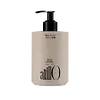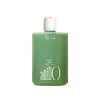What's inside
What's inside
 Key Ingredients
Key Ingredients

 Benefits
Benefits

 Concerns
Concerns

 Ingredients Side-by-side
Ingredients Side-by-side

Water
Skin ConditioningDisodium Laureth Sulfosuccinate
CleansingGlycine Soja Seed Extract
Skin ConditioningLactobacillus Ferment Lysate
Skin ConditioningSaccharomyces Ferment Filtrate
HumectantCocamidopropyl Hydroxysultaine
CleansingSodium Cocoyl Isethionate
CleansingCoco-Glucoside
CleansingAcrylates Copolymer
Parfum
MaskingSodium Lauroyl Methylaminopropionate
CleansingDecyl Glucoside
CleansingArginine
MaskingSodium Chloride
MaskingMethylpropanediol
SolventMannitol
HumectantStyrene
Perfuming1,2-Hexanediol
Skin ConditioningCaprylyl Glycol
EmollientPolyquaternium-22
PPG-3 Caprylyl Ether
SolventCetyl Alcohol
EmollientTrihydroxystearin
Skin ConditioningPanthenol
Skin ConditioningPolyquaternium-10
Salicylic Acid
MaskingMicrocrystalline Cellulose
AbsorbentSucrose
HumectantEthylhexylglycerin
Skin ConditioningNiacinamide
SmoothingZea Mays Starch
AbsorbentMalt Extract
Skin ProtectingDisodium EDTA
Hydroxypropyl Methylcellulose
Emulsion StabilisingCitric Acid
BufferingBenzoic Acid
MaskingButylene Glycol
HumectantMyristyl Alcohol
EmollientCocamide Mipa
EmulsifyingHyaluronic Acid
HumectantTriticum Vulgare Germ Extract
Skin ConditioningStearyl Alcohol
EmollientLactobacillus
Skin ConditioningAvena Sativa Kernel Extract
AbrasiveOryza Sativa Extract
AbsorbentSalmon Egg Extract
Berberis Vulgaris Root Extract
AntimicrobialFragaria Chiloensis Fruit Extract
Skin ConditioningLycium Barbarum Fruit Extract
AstringentMorus Alba Fruit Extract
AntioxidantHydrolyzed Wheat Protein
Skin ConditioningPropanediol
SolventLinalool
PerfumingWater, Disodium Laureth Sulfosuccinate, Glycine Soja Seed Extract, Lactobacillus Ferment Lysate, Saccharomyces Ferment Filtrate, Cocamidopropyl Hydroxysultaine, Sodium Cocoyl Isethionate, Coco-Glucoside, Acrylates Copolymer, Parfum, Sodium Lauroyl Methylaminopropionate, Decyl Glucoside, Arginine, Sodium Chloride, Methylpropanediol, Mannitol, Styrene, 1,2-Hexanediol, Caprylyl Glycol, Polyquaternium-22, PPG-3 Caprylyl Ether, Cetyl Alcohol, Trihydroxystearin, Panthenol, Polyquaternium-10, Salicylic Acid, Microcrystalline Cellulose, Sucrose, Ethylhexylglycerin, Niacinamide, Zea Mays Starch, Malt Extract, Disodium EDTA, Hydroxypropyl Methylcellulose, Citric Acid, Benzoic Acid, Butylene Glycol, Myristyl Alcohol, Cocamide Mipa, Hyaluronic Acid, Triticum Vulgare Germ Extract, Stearyl Alcohol, Lactobacillus, Avena Sativa Kernel Extract, Oryza Sativa Extract, Salmon Egg Extract, Berberis Vulgaris Root Extract, Fragaria Chiloensis Fruit Extract, Lycium Barbarum Fruit Extract, Morus Alba Fruit Extract, Hydrolyzed Wheat Protein, Propanediol, Linalool
Water
Skin ConditioningMantis Extract
Skin ConditioningSodium C14-16 Olefin Sulfonate
CleansingGlycerin
HumectantCocamidopropyl Hydroxysultaine
CleansingAcrylates Copolymer
Butylene Glycol
Humectant1,2-Hexanediol
Skin ConditioningParfum
MaskingMenthol
MaskingTromethamine
BufferingC12-14 Pareth-12
EmulsifyingCitrus Limon Peel Powder
AbsorbentSodium Chloride
MaskingNymphaea Lotus Root Extract
AstringentCaprylyl Glycol
EmollientEthylhexylglycerin
Skin ConditioningDisodium EDTA
Polyquaternium-10
Citrus Aurantium Dulcis Peel Oil
MaskingMyristica Fragrans Aril Oil
PerfumingCitrus Limon Peel Oil
MaskingPunica Granatum Extract
AstringentCitric Acid
BufferingPanthenol
Skin ConditioningMelaleuca Alternifolia Leaf Extract
PerfumingPyrus Malus Fruit Extract
Skin ConditioningClitoria Ternatea Flower Extract
Skin ConditioningGarcinia Mangostana Peel Extract
Skin ConditioningEucalyptus Alba Leaf Extract
Skin ConditioningHouttuynia Cordata Extract
Skin ConditioningAloe Barbadensis Leaf Extract
EmollientCymbopogon Schoenanthus Extract
Skin ConditioningCamellia Sinensis Leaf Extract
AntimicrobialAspergillus/Buckwheat Ferment Extract
AntioxidantNelumbo Nucifera Flower Extract
Skin ConditioningOryza Sativa Extract
AbsorbentTerminalia Ferdinandiana Fruit Extract
AntioxidantVaccinium Angustifolium Fruit Extract
Skin ProtectingLimus Extract
Skin ConditioningPropylene Glycol Laurate
Skin ConditioningSodium Citrate
BufferingErythritol
HumectantMentha Piperita Leaf Extract
Skin ConditioningVinca Minor Leaf Extract
Skin ConditioningSalvia Officinalis Leaf Extract
CleansingLimonene
PerfumingWater, Mantis Extract, Sodium C14-16 Olefin Sulfonate, Glycerin, Cocamidopropyl Hydroxysultaine, Acrylates Copolymer, Butylene Glycol, 1,2-Hexanediol, Parfum, Menthol, Tromethamine, C12-14 Pareth-12, Citrus Limon Peel Powder, Sodium Chloride, Nymphaea Lotus Root Extract, Caprylyl Glycol, Ethylhexylglycerin, Disodium EDTA, Polyquaternium-10, Citrus Aurantium Dulcis Peel Oil, Myristica Fragrans Aril Oil, Citrus Limon Peel Oil, Punica Granatum Extract, Citric Acid, Panthenol, Melaleuca Alternifolia Leaf Extract, Pyrus Malus Fruit Extract, Clitoria Ternatea Flower Extract, Garcinia Mangostana Peel Extract, Eucalyptus Alba Leaf Extract, Houttuynia Cordata Extract, Aloe Barbadensis Leaf Extract, Cymbopogon Schoenanthus Extract, Camellia Sinensis Leaf Extract, Aspergillus/Buckwheat Ferment Extract, Nelumbo Nucifera Flower Extract, Oryza Sativa Extract, Terminalia Ferdinandiana Fruit Extract, Vaccinium Angustifolium Fruit Extract, Limus Extract, Propylene Glycol Laurate, Sodium Citrate, Erythritol, Mentha Piperita Leaf Extract, Vinca Minor Leaf Extract, Salvia Officinalis Leaf Extract, Limonene
Ingredients Explained
These ingredients are found in both products.
Ingredients higher up in an ingredient list are typically present in a larger amount.
1,2-Hexanediol is a synthetic liquid and another multi-functional powerhouse.
It is a:
- Humectant, drawing moisture into the skin
- Emollient, helping to soften skin
- Solvent, dispersing and stabilizing formulas
- Preservative booster, enhancing the antimicrobial activity of other preservatives
Acrylates Copolymer is used as a film-forming agent and texture enhancer.
After applied, Acrylates Copolymer forms a thin film cover that helps skin feel more soft. It can help sunscreens become more water-resistant.
It is also used to make a product more thick.
Learn more about Acrylates CopolymerButylene Glycol (or BG) is used within cosmetic products for a few different reasons:
Overall, Butylene Glycol is a safe and well-rounded ingredient that works well with other ingredients.
Though this ingredient works well with most skin types, some people with sensitive skin may experience a reaction such as allergic rashes, closed comedones, or itchiness.
Learn more about Butylene GlycolCaprylyl Glycol is a humectant and emollient, meaning it attracts and preserves moisture.
It is a common ingredient in many products, especially those designed to hydrate skin. The primary benefits are retaining moisture, skin softening, and promoting a healthy skin barrier.
Though Caprylyl Glycol is an alcohol derived from fatty acids, it is not the kind that can dry out skin.
This ingredient is also used as a preservative to extend the life of products. It has slight antimicrobial properties.
Learn more about Caprylyl GlycolCitric Acid is an alpha hydroxy acid (AHA) naturally found in citrus fruits like oranges, lemons, and limes.
Like other AHAs, citric acid can exfoliate skin by breaking down the bonds that hold dead skin cells together. This helps reveal smoother and brighter skin underneath.
However, this exfoliating effect only happens at high concentrations (20%) which can be hard to find in cosmetic products.
Due to this, citric acid is usually included in small amounts as a pH adjuster. This helps keep products slightly more acidic and compatible with skin's natural pH.
In skincare formulas, citric acid can:
While it can provide some skin benefits, research shows lactic acid and glycolic acid are generally more effective and less irritating exfoliants.
Most citric acid used in skincare today is made by fermenting sugars (usually from molasses). This synthetic version is identical to the natural citrus form but easier to stabilize and use in formulations.
Read more about some other popular AHA's here:
Learn more about Citric AcidCocamidopropyl Hydroxysultaine is a synthetic cleansing agent, though it is derived from coconut oil.
It is used to enhance the texture of products by boosting lather and thickening the texture. As a cleanser, Cocamidopropyl Hydroxysultaine is mild.
Disodium EDTA plays a role in making products more stable by aiding other preservatives.
It is a chelating agent, meaning it neutralizes metal ions that may be found in a product.
Disodium EDTA is a salt of edetic acid and is found to be safe in cosmetic ingredients.
Learn more about Disodium EDTAEthylhexylglycerin (we can't pronounce this either) is commonly used as a preservative and skin softener. It is derived from glyceryl.
You might see Ethylhexylglycerin often paired with other preservatives such as phenoxyethanol. Ethylhexylglycerin has been found to increase the effectiveness of these other preservatives.
Oryza Sativa Extract comes from the rice grain, Oryza sativa. Rice extract has wound healing, antioxidant, anti-inflammatory, and hydrating properties.
Rice grains contain numerous antioxidants which may help with anti-aging, such as vitamin E. Antioxidants help stabilize free-radical molecules. Unstable free-radical molecules may damage your skin cells and accelerate signs of aging.
A study from 2002 found rice to help increase the rate of wound healing. The same study found an improvement of skin barrier function in the patients after taking rice baths.
Numerous in-vitro studies have found rice water to help decrease sun damage by increasing collagen production and inhibiting the process of tyrosinase.
Long story short- tyrosinase is an enzyme that controls melanin production. Our bodies start producing melanin (AKA tanning) when exposed to UV radiation to protect against damage. Rice water is found to partially block this process.
Though more research is needed on rice's ability to help with UV protection, recent studies seem promising.
Wondering why rice is hydrating? The protein in rice have emollient properties. Emollients create a barrier on the skin to trap moisture in, keeping your skin moisturized.
Some rice extract may have mildly-exfoliating properties. These are mainly limited to Oryza Sativa (Rice) Bran and Oryza Sativa (Rice) Germ Powder.
This rice was first cultivated in China over 10,000 years ago. Many cultures throughout Asia have used rice water on skin and hair for centuries.
Learn more about Oryza Sativa ExtractPanthenol is a common ingredient that helps hydrate and soothe the skin. It is found naturally in our skin and hair.
There are two forms of panthenol: D and L.
D-panthenol is also known as dexpanthenol. Most cosmetics use dexpanthenol or a mixture of D and L-panthenol.
Panthenol is famous due to its ability to go deeper into the skin's layers. Using this ingredient has numerous pros (and no cons):
Like hyaluronic acid, panthenol is a humectant. Humectants are able to bind and hold large amounts of water to keep skin hydrated.
This ingredient works well for wound healing. It works by increasing tissue in the wound and helps close open wounds.
Once oxidized, panthenol converts to pantothenic acid. Panthothenic acid is found in all living cells.
This ingredient is also referred to as pro-vitamin B5.
Learn more about PanthenolParfum is a catch-all term for an ingredient or more that is used to give a scent to products.
Also called "fragrance", this ingredient can be a blend of hundreds of chemicals or plant oils. This means every product with "fragrance" or "parfum" in the ingredients list is a different mixture.
For instance, Habanolide is a proprietary trade name for a specific aroma chemical. When used as a fragrance ingredient in cosmetics, most aroma chemicals fall under the broad labeling category of “FRAGRANCE” or “PARFUM” according to EU and US regulations.
The term 'parfum' or 'fragrance' is not regulated in many countries. In many cases, it is up to the brand to define this term.
For instance, many brands choose to label themselves as "fragrance-free" because they are not using synthetic fragrances. However, their products may still contain ingredients such as essential oils that are considered a fragrance by INCI standards.
One example is Calendula flower extract. Calendula is an essential oil that still imparts a scent or 'fragrance'.
Depending on the blend, the ingredients in the mixture can cause allergies and sensitivities on the skin. Some ingredients that are known EU allergens include linalool and citronellol.
Parfum can also be used to mask or cover an unpleasant scent.
The bottom line is: not all fragrances/parfum/ingredients are created equally. If you are worried about fragrances, we recommend taking a closer look at an ingredient. And of course, we always recommend speaking with a professional.
Learn more about ParfumPolyquaternium-10 is an ammonium salt of hydroxyethylcellulose. It is a white and granular powder used as a film-former and anti-static agent.
This ingredient is commonly found in hair conditioning products. According to a manufacturer, its positive charge makes it great for absorbing hair proteins. The manufacturer also states this ingredient helps with curl retention.
For haircare friends: this ingredient is not a silicone.
Learn more about Polyquaternium-10Chances are, you eat sodium chloride every day. Sodium Chloride is also known as table salt.
This ingredient has many purposes in skincare: thickener, emulsifier, and exfoliator.
You'll most likely find this ingredient in cleansers where it is used to create a gel-like texture. As an emulsifier, it also prevents ingredients from separating.
There is much debate on whether this ingredient is comedogenic. The short answer - comedogenic ratings don't tell the whole story. Learn more about comegodenic ratings here.
The concensus about this ingredient causing acne seems to be divided. Research is needed to understand if this ingredient does cause acne.
Scrubs may use salt as the primary exfoliating ingredient.
Learn more about Sodium ChlorideWater. It's the most common cosmetic ingredient of all. You'll usually see it at the top of ingredient lists, meaning that it makes up the largest part of the product.
So why is it so popular? Water most often acts as a solvent - this means that it helps dissolve other ingredients into the formulation.
You'll also recognize water as that liquid we all need to stay alive. If you see this, drink a glass of water. Stay hydrated!
Learn more about Water